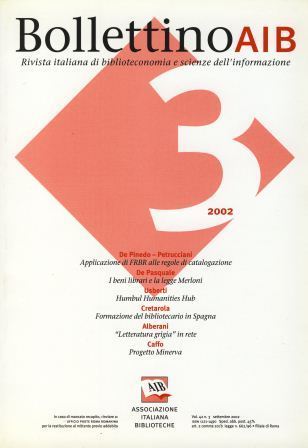I beni librari e la legge Merloni
Main Article Content
Abstract
The coming into force of the amendments to the decree identifying "those who carry out works of restoration and maintenance of the patrimony and decorated surfaces of the architectural heritageŜ can be said to mark the conclusion of the new legislative corpus on the restoration of cultural patrimony in general and of library resources in particular. This iter had begun in 1994 with the writing of the more general law with regard to public works. It is now possible to present an overall picture of the question in the light also of the first, difficult, application experiences.
The way in which the restoration of library resources, included in the category of "goods of historical and artistic interest", is dealt with - that is to say, with procedures identical to those of other public works, and also of other cultural resources of a distinctly different kind and approach (such as architectural resources) - does in fact represent on the one hand the final "liberation" of an activity that up to just a few years ago was confused with bookbinding and had exclusively artisan characteristics. However, due to the forced nature of the law, it has also produced a tumult of questions of practical management that have yet in certain cases to be solved.
The ministerial decree no. 294/2000, with its amendments, has basically defined the formative procedure for restorers and assistant restorers. It identifies state schools with high Ministerial training levels for cultural heritage and activities and universities with degree courses in the preserving and restoration of the historical-artistic patrimony as the preferred bodies for training assistant restorers, while it does not identify particular skills for restoration personnel. In fact the terms restorer or assistant restorer of cultural resources cover all the professional skills, whatever they may be, without acknowledging that it is rare indeed that a restorer is trained in all aspects of the techniques and methodologies of the restoration of different materials. It would rather be opportune to link the skills required for the personnel with the nature of the work to be done, so making an ulterior step towards the recognition of restoration as a specialized activity, and thus also guaranteeing that companies with unskilled personnel cannot take on jobs that they are not in a position to carry out.
The way in which the restoration of library resources, included in the category of "goods of historical and artistic interest", is dealt with - that is to say, with procedures identical to those of other public works, and also of other cultural resources of a distinctly different kind and approach (such as architectural resources) - does in fact represent on the one hand the final "liberation" of an activity that up to just a few years ago was confused with bookbinding and had exclusively artisan characteristics. However, due to the forced nature of the law, it has also produced a tumult of questions of practical management that have yet in certain cases to be solved.
The ministerial decree no. 294/2000, with its amendments, has basically defined the formative procedure for restorers and assistant restorers. It identifies state schools with high Ministerial training levels for cultural heritage and activities and universities with degree courses in the preserving and restoration of the historical-artistic patrimony as the preferred bodies for training assistant restorers, while it does not identify particular skills for restoration personnel. In fact the terms restorer or assistant restorer of cultural resources cover all the professional skills, whatever they may be, without acknowledging that it is rare indeed that a restorer is trained in all aspects of the techniques and methodologies of the restoration of different materials. It would rather be opportune to link the skills required for the personnel with the nature of the work to be done, so making an ulterior step towards the recognition of restoration as a specialized activity, and thus also guaranteeing that companies with unskilled personnel cannot take on jobs that they are not in a position to carry out.
Article Details
Section
Articles

This work is licensed under a Creative Commons Attribution-ShareAlike 4.0 International License.
